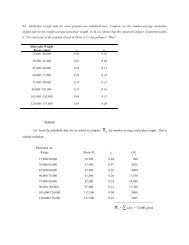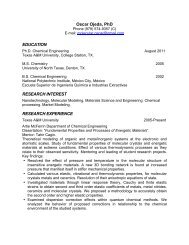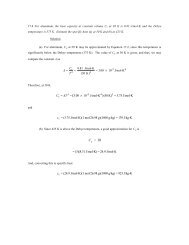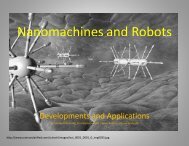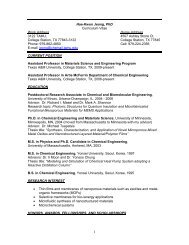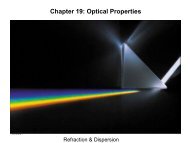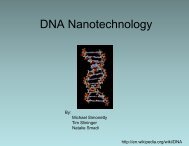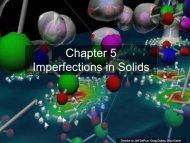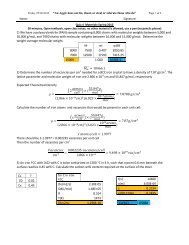The Nanocell: A Chemically Assembled Molecular ... - IEEE Xplore
The Nanocell: A Chemically Assembled Molecular ... - IEEE Xplore
The Nanocell: A Chemically Assembled Molecular ... - IEEE Xplore
Create successful ePaper yourself
Turn your PDF publications into a flip-book with our unique Google optimized e-Paper software.
1616 <strong>IEEE</strong> SENSORS JOURNAL, VOL. 6, NO. 6, DECEMBER 2006However, there are factors that may have strong influencein the end of the scaling down of semiconductor electronics[15]. <strong>The</strong>se are tunneling of electrons at short distances (leaksand avalanche breakdown), uncontrollable or impractical heatdissipation, and rare or nonuniform doping. One way to solvethis problem would be to find better materials, but this willonly solve problems marginally, as silicon is the most suitablematerial among bulk materials for the lithographic fabricationtechniques. No matter what material is used, tunneling ofelectrons is unstoppable, as any material is equally subjected tothe laws of quantum mechanics; what we need are new devicesoperating under different mechanisms.Even if devices can be scaled down further, addressed, andinterconnected using CMOS or any other material or technology,heat removal problems are going to increase simplybecause current through the devices cannot be scale downequally because signal/noise ratios cannot be decreased withoutjeopardizing signal integrity. As devices are smaller, electroncurrent carrying information creates stronger perturbations,affecting their performance. <strong>The</strong>refore, any approach that wewant to develop has to consider the need to change the way weencode information in the computing circuits. <strong>The</strong>re are severalalternatives that might be used alone or in combination to solvethe dissipation problem caused by electrical currents. Possiblealternatives, instead of a charge-current approach, are the molecularelectrostatic potential (MEP) to encode and process information[16], the molecular vibrational states for the transportof signal in molecular circuits [17]–[20], the quantum cellularautomata for transfer and processing of information [21], thespin (spintronics) to encode and process information [22], themechanical bonds to process information [23]–[25], torsionaleffect in molecules to process and amplify signals [26], [27],and the molecular reactivity (breaking-forming bonds, electromigration,etc) to process information [28]. As all of theseprocesses are of atomistic and molecular in nature, the nanocellconcept is suitable in operating under any of the above scenariosfollowing the famous dictum “there is plenty of room at thebottom” by Feynman. Thus, since there is no limitation on thelevel of matter to be used as matter definitely computes, nothingkeeps us from thinking that, in the future, we will be usingquarks or even superstrings or any other exotic kind of waveparticlemoiety for computation.III. AREN’T COMPUTERS FAST ENOUGH?<strong>The</strong> answer is a straight no. Despite the power of presentcomputers, more is needed. <strong>The</strong> scientific and technologicalcommunity feels that there are no evident trends to get morecomputational power and there is no clear definition of theproblems that need to be solved to get more computationalpower; however, we plan activities, considering that computerswill be twice faster every ∼18 months. Analysis, design, andsimulation in all areas of science and technology depend on theavailability of faster computers able to provide useful informationabout the outcome of projects or experiments prior to theirreal implementation or construction, thus avoiding high costs oftrial-error experimentation. As a simple example among manyothers, the physics and chemistry of materials would allow theconstruction and design of materials with tailored propertiesusing well-known (for more than 80 years) and precise equationsof nature governing the behavior of these materials. However,because of the lack of sufficient computational resources,the numerical solution of these precise equations needed for theanalysis of realistic systems cannot be done. Solution of theequations demands excessive computational resources, so thatwe are limited to solve those using strongly approximatedmodels.Although impressive advances are constantly achieved inmicroelectronics technology, current computers based on siliconCMOS IC fabricated with precise lithographic techniquesalready show problems of scaling-down and miniaturization aswe approach the 10-nm limit.One alternative parallel to the nanocell is simply substitutingpresent semiconductor devices and systems with molecularones. This alternative is in direct competition with siliconelectronics. Typical applications are already in progress, suchas several crossbar approaches [29]–[46] that will allow us toconstruct molecular memories and logic, hopefully at extremelylower fabrication costs. On the other hand, magnetic storagedevices, in which magnetic states are used to store informationpermanently, are also being developed [47]–[58].IV. PHYSICAL LIMITATIONSAs they become smaller, the sharp properties of digital devicesused to handle logical operations become fuzzy. Deviceslose several of their bulk properties when approaching thesmaller structures of atoms like molecules or nanoclusters.<strong>The</strong>se problems are common to any material used to fabricateelectronic devices, as they depend on the physics governingsmall amounts of matter. For instance the diode, which is thesimplest electronic device, its ideal characteristics are zeroresistance under direct bias (ON state) and infinite resistanceunder reverse bias (OFF state); the ratio of the current at ON andOFF states is infinite. This is almost the case when using vacuumtubes and certainly far from the ideal but still acceptable whenusing semiconductor diodes; practical diodes show a few ohmsunder direct bias and few giga or megohms at reverse bias;typical ON/OFF ratios are between 10 3 −10 6 . With single molecules,a few kilohms would be expected in the direct and severalin the reverse case; ON–OFF ratios bigger than one order ofmagnitude would be very difficult to obtain from single moleculesat the nanometer size. <strong>The</strong> physics behind this problem is“tunneling.” Basically, electrons cannot be kept at designatedtracks and sites; they tunnel through potential barriers thatwere supposed to maintain sharp ON and OFF changes of thedevices.Even if the fuzziness between ON and OFF states in digitalcircuits can be solved by sophisticated signal processing anderror correction techniques, still there is the problem of fabricationand addressing these small devices. Present fabricationtechniques are photolithography-based, a top-down technique,which practically puts the entire burden in the design andfabrication of a mask able to expose the silicon substrate usingan electromagnetic radiation of a specific wavelength, determiningto some extent the minimum feature. Thus, fabrication




